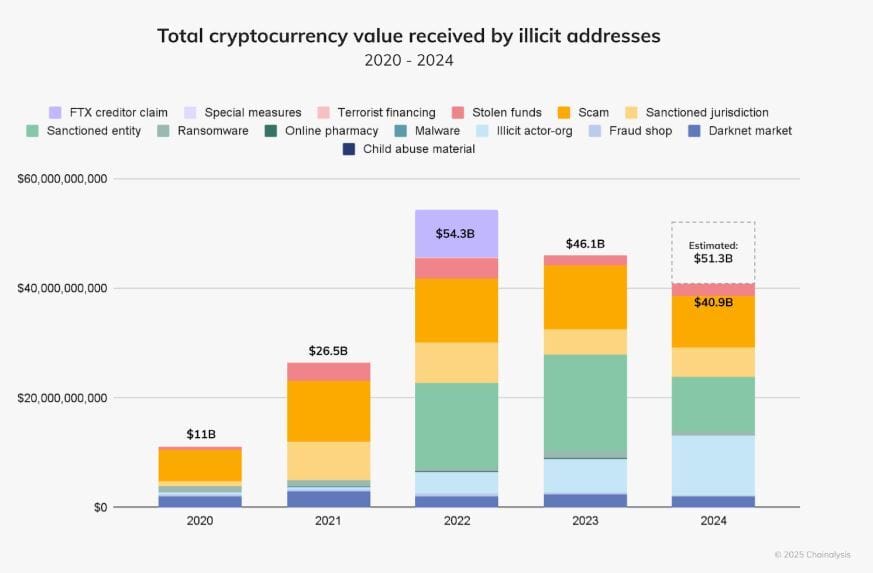Illicit On-Chain Activity Expands Beyond Cybercrime to National Threats: Chainalysis
As cryptocurrency gains mainstream traction, its use in illicit activities has diversified, extending beyond traditional cybercrime. Chainalysis has warned that these activities even include threats like national security breaches and consumer exploitation.
In fact, these illicit actors increasingly utilize on-chain platforms for laundering, even if they operate primarily off-chain. This shift has led to the professionalization of the on-chain illicit ecosystem, with sophisticated networks and services emerging to facilitate various forms of crypto crime.
Sextortion, KYC Bypasses, and More in 2024
According to the official press release by Chainalysis shared with CryptoPotato, illicit cryptocurrency addresses were found to have received $40.9 billion in 2024, showing a decline in this number. Yet, this figure is a conservative estimate, limited to inflows to known illicit addresses identified to date.
The blockchain analysis firm expects the final total to be higher, even hinting that 2024 may have seen the highest-ever inflows to illicit entities.
“It stands to reason that 2024’s illicit cryptocurrency volume will exceed that of 2023. Since 2020, our annual estimates of illicit activity – which include both evidentiary attributions and Chainalysis Signals data – have grown by an average of 25% between annual reporting periods. Assuming a similar growth rate between now, our annual totals for 2024 could surpass the $51 billion threshold.”

Meanwhile, fraud and scams flourished in 2024 as high-yield investment schemes and pig butchering emerged as the most lucrative methods.
Artificial intelligence (AI) has become a powerful tool in these schemes, enabling hyper-personalized sextortion attacks and supporting broader trends in cybercrime, such as bypassing KYC protocols through AI-powered services. Fraudsters are also employing guarantee services like Huione and exploiting crypto ATM scams, which are particularly troubling due to their impact on elderly victims.
2023 Darknet Market Earnings Fall Short of 2022
The stolen funds rose by roughly 21% year-over-year to $2.2 billion in 2024. While decentralized finance (DeFi) platforms accounted for the largest portion of stolen funds, centralized services were more frequently targeted in the second and third quarters.
Private key compromises were responsible for 43.8% of the stolen cryptocurrency. North Korean hackers stole a whopping $1.34 billion from crypto platforms, which accounted for 61% of the year’s total. Some of these attacks are linked to North Korean IT workers who have infiltrated crypto and web3 companies, exploiting their networks with advanced tactics, techniques, and procedures (TTPs).
Chainalysis also reported that the ransomware revenues remain in the hundreds of millions, though major law enforcement operations and decreased victim willingness to pay ransoms have weakened the ecosystem. Despite this, 2024 has been a busy year that saw continued attack volumes and some ransomware groups securing smaller-scale payments.
The post Illicit On-Chain Activity Expands Beyond Cybercrime to National Threats: Chainalysis appeared first on CryptoPotato.









